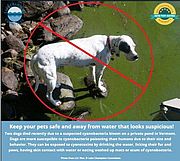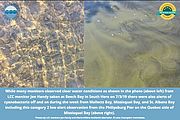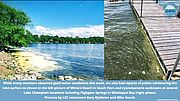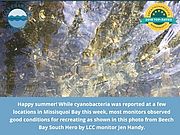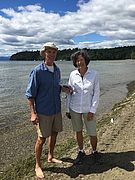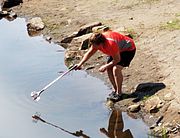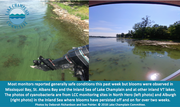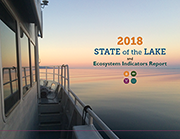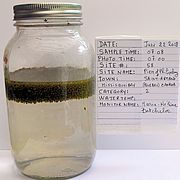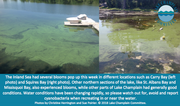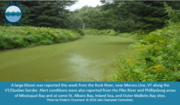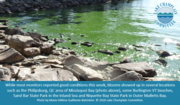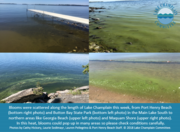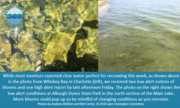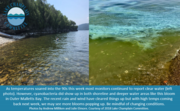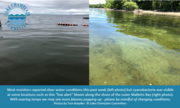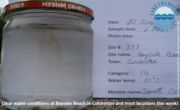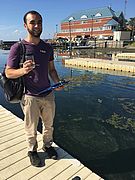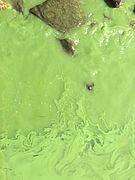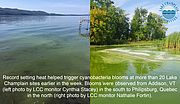We saw a lot of volatility in conditions this week on Lake Champlain. Heavy rains flushed things out in some areas and in others provided additional nutrients to fuel cyanobacteria growth. Blooms showed up along the New York shoreline, in St. Albans Bay, Missisquoi Bay and along the Burlington and South Burlington shorelines and at Vermont inland waterways of Bald Hill Pond and Shelburne Pond. We also received word that two dogs recently died due to ingesting cyanobacteria from a private pond in Vermont. Please remind dog owners to be vigilant about protecting their pets and keep them away from water with cyanobacteria.
News from Selected Category
We had over 150 water quality observations from Lake Champlain and inland waterway monitors this week! Most were of good conditions but cyanobacteria was reported from Lake Champlain sites in Malletts Bay, St. Albans Bay and Missisquoi Bay. You’ll find further information and links below about cyanobacteria and how to recognize and report it. We’ve also included a photo of a mystery phenomena we are trying to identify (stay tuned for results next week) and a picture of the invasive fishhook waterflea. Populations of this aggressive, predatory zooplankton have increased dramatically since they were first discovered in Lake Champlain last September.
We had reports from 135 different sites this week with low alert sitings of cyanobacteria from Lake Champlain’s Missisquoi Bay, St. Albans Bay and Knapp Pond in Cavendish, VT. High alert bloom conditions persisted at Outer Malletts Bay on June 26 and 27 and improved to low alert conditions on Friday. Happily, most other monitors reported good conditions.
Happy start of summer! Cyanobacteria monitoring got underway earlier this week, toxin testing and phytoplankton analysis at selected shoreline locations on Lake Champlain will get underway next week as well. We are excited to have such a great crew of citizen scientists assessing water conditions! Low alert conditions were observed on the eastern side of Missisquoi Bay and some cyanobacteria was seen in the water at Niquette Bay State Park this week. All other areas of Lake Champlain along with inland Vermont lakes reported good conditions. Read...
Help assess Lake Champlain water conditions around the lake. Complete our cyanobacteria monitor interest form if you're interested in monitoring or want to attend a training session to learn more about the lake. Feel free to share this invite with other lake lovers.
According to a report released by the Rhodium Group, a private climate-research firm, carbon dioxide emissions in the U.S. increased by roughly 3.4% in 2018 – this after three years of decline. The report points to a particularly cold winter and economic growth as the main contributors. While this appears to pit climate change reductions against economic growth, it’s entirely possible to lower emissions while improving the economy. Climate change is a leading contributor to many expensive environmental issues, including increased cyanobacteria blooms, stormwater runoff, and other water quality concerns.
Deep thanks to all our cyanobacteria monitors for their diligent work during the 2018 season. Many began assessing site conditions in mid-June and filed their final report 19 weeks later in mid-October. LCC monitors and our partners at the Vermont and New York Departments of Health and Environmental Conservation gathered data from nearly 150 sites in the Lake Champlain watershed and filed more than 1,800 reports about water conditions.
The 2018 cyanobacteria monitoring season has come to a close! Read the final report of 2018 to see the season statistics, learn about recent lake phenomena and find ways to stay involved until next year! Thank you to everyone who helped make this another successful monitoring season!
Despite cooler, windy weather, blooms still showed up in parts of Lake Champlain and Lake Memphremagog during the week. While cooler temperatures may cause blooms to dissipate, the same weather can stimulate blooms in other lakes.
Blooms showed up in the Inland Sea, Main Lake Central, St. Albans Bay and Missisquoi Bay sections of Lake Champlain and several inland lakes this week. Cooler, windy weather blew into the region late in the week providing a welcome change in temperature.
Blooms showed up in many sections of Lake Champlain and at inland lakes as well, keeping monitors busy. Sincere thanks for the diligent reporting and a special shout out to interested citizens who took the time to do some online training about cyanobacteria and report in about conditions observed. We greatly appreciate your efforts!
Monitors reported generally safe conditions from most Lake Champlain and inland waterways during the past week, however blooms were observed in St. Albans Bay, the Inland Sea and Missisquoi Bay and on several smaller waterways. While many people think of cyanobacteria blooms as a summer phenomenon, they can also persist in the fall. In fact, this weekend’s cooler temperatures may trigger turn over in some of our smaller lakes and ponds.
It’s been another busy week of monitoring with 121 reports filed for Lake Champlain and inland lake locations. While good conditions persisted at most locations, blooms did show up on some inland lakes and on all sections of Lake Champlain except for the South Lake. Please be mindful that conditions can change rapidly.
From July 18 to August 16, a stretch of 29 days, the daily high temperature in Burlington, Vermont never fell below 80 degrees F. The streak eclipsed the previous record for consecutive days over 80 by four days. Keep in mind, the streak of hot days began AFTER temperatures climbed into the 90s for six straight days earlier in July. During that heat streak the region set another record, the highest ever daily low temperature of 80 degrees.
“This report helps the public to interpret information about the Lake using the best scientific data available. Lake managers use this information to develop and assess strategies for improving water quality in Lake Champlain,” said Dr. Eric Howe, LCBP Director. “In the 2018 report, we provide updated information on the many issues facing Lake Champlain.”
Hats off to the great group of dedicated cyanobacteria monitoring volunteers who are reporting on water quality from over 100 Lake Champlain shoreline locations and inland lakes. LCC has trained nearly 300 individuals this season to identify cyanobacteria, including state and municipal recreational staff and water treatment system operators.
Stay up to date on water conditions on Lake Champlain and inland lakes with LCC’s weekly cyanobacteria reports. The report compiles and summarizes data collected from over 100 LCC monitoring sites in New York, Vermont and Quebec. It also includes helpful information on how to recognize and report cyanobacteria and actions to take to reduce bloom frequency.
Clear water was generally reported this week from most sections of Lake Champlain, with the exception of several alert level conditions observed by monitors in northern sections of the lake like the Inland Sea, St. Albans Bay and Missisquoi Bay. Conditions have been changing daily at some locations, so please keep a watchful eye and use the links and resources in this email to learn <link lcc-at-work algae-in-lake>ways to recognize and <link get-involved volunteers cyanobacteriamonitors cyanobacteria-monitor-reporting-form>report on cyanobacteria. Read...
While good conditions were primarily reported this week, blooms popped up in many sections of the lake and at some inland lakes. As of late afternoon Friday (8/17/18) we received 120 reports from Lake Champlain and inland lake sites. Scroll down to see pictures of the filamentous green algae scums that were showing up in some areas of the lake. People often confuse decaying green algae with cyanobacteria. Read...
Yet another busy week of monitoring as alert level conditions were reported from several Lake Champlain locations and inland lakes. A large bloom was observed at the Rock River near Morses Line, Vermont on the VT/Quebec border and also in the Saxtons River Recreation Area in Rockingham, VT. There’s stagnant warm water in rivers across the region due to the lack of rain. Please spread the word that blooms aren’t restricted to lakes and ponds, they can be found in rivers as well.Read...
July was a hot, steamy month with blooms popping up in various places around the lake. (July was officially the hottest for Burlington VT since the National Weather Service began keeping records in 1892.) The high heat and sultry weather has continued into August, a time of year when cyanobacteria blooms are more common. Please enjoy the water but keep a careful watch for cyanobacteria. Read...
Another busy week that brought much needed rain. While most Lake Champlain Committee (LCC) monitors reported good conditions throughout the week, some blooms did show up on Lake Champlain but not at any of the inland lakes that reported this week.Additionally, on Friday morning (7/27) two Burlington, VT beaches (Blanchard at Oakledge Park and Leddy Beach) were closed due to E.coli from stormwater flows after recent heavy rains. Read...
Lake Champlain Committee (LCC) monitors were busy assessing conditions throughout the watershed during this hot, dry week. We received 139 reports from Lake Champlain and inland lake sites. Hot, still weather is ideal for cyanobacteria so please be mindful of changing conditions and keep a careful watch on the water. You’ll find further details of this week’s reports below. Read...
It’s been another hot week, but quiet in terms of cyanobacteria blooms all week until Friday afternoon. While most monitors reported conditions great for recreating throughout the week, we received a low alert bloom notice of cyanobacteria at Alburgh Dunes State Park in the North Main Lake mid-afternoon today and late in the day reports of low and high alert blooms at two sites in the Inland Sea. You’ll find further details of this week’s results below along with background information about LCC’s monitoring program. Read...
What a hot week of record-breaking temperatures! Lake Champlain Committee (LCC) monitors filed 140 reports for Lake Champlain and inland lakes. Most observed clear water, great for cooling off in during the heat wave. However, there were some sightings of cyanobacteria, mainly in Outer Malletts Bay and the Inland Sea on Lake Champlain and at some inland lakes. Happily most conditions improved by mid-week. Read...
It’s been a busy week for the Lake Champlain Committee Cyanobacteria Monitoring Program with over 130 reports from Lake Champlain and inland lakes! While most monitors observed clear water, perfect for cooling off in, we did receive some reports of cyanobacteria from Malletts Bay and several inland lakes. Read...
Thank you for signing up to receive the Lake Champlain Committee’s (LCC) summer cyanobacteria monitoring reports! Monitors reported in from more than 80 locations this past week, mainly noting clear water conditions great for recreating. While there were no reports of cyanobacteria for Lake Champlain locations and many inland lakes there was a cyanobacteria bloom observed in a feeder stream near Hall’s Bay in Lake St. Catherine in Poultney, Vermont.
We're gearing up for the summer monitoring season and are looking for people to report on water quality. LCC cyanobacteria monitors receive training to assess water conditions, visit the same site throughout the season and file a weekly online report from mid-June through the end of September.
Read...In late December 2017, New York Governor Andrew Cuomo announced a $65 million four-point initiative to aggressively combat harmful algal blooms (HABs) in Upstate New York waters. Twelve lakes that are vulnerable to HABs and are critical drinking water sources and vital tourism drivers were chosen as priority waterbodies. Lake Champlain and Lake George are two of the twelve that will receive greater focus. Lessons learned will be applied to other impacted waterbodies moving forward. Read...
From September 24 through mid-week, a record-setting heat wave helped spawn or perpetuate blooms at over 20 monitoring sites along the Lake Champlain shoreline. The wet spring and summer had already flushed lots of nutrients into our waterways priming conditions for cyanobacteria to take off during the spate of hot, still weather.
Read...
